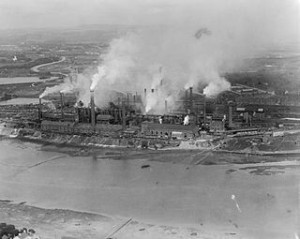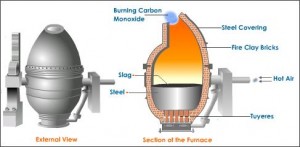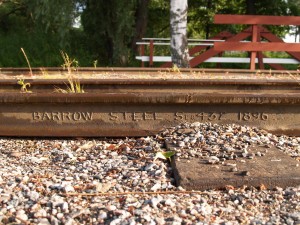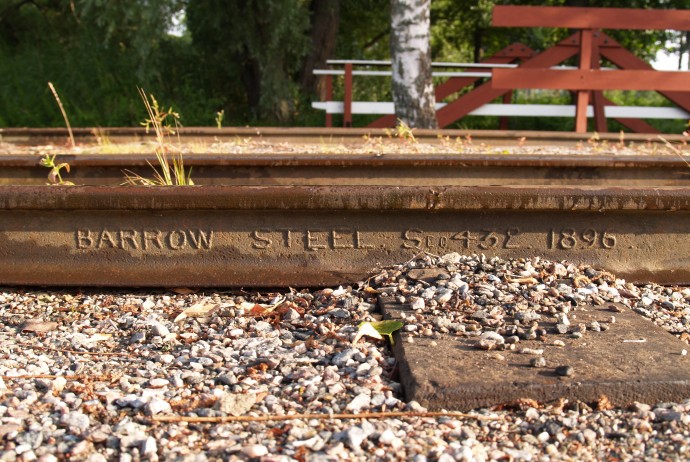
Barrow Steelworks – Largest Steel Producer in World During beginning of the 20th Century
by Unknown, used under 
The Steel Industry
By: Jim Elias
Steel
The Siemens-Martin Process
During the 1860’s the Siemens-Martin Process was used to produce steel which helped Europe’s industrial revolution grow quickly. The process consists of heating pig iron in a metallurgical furnace, otherwise known as the Bessemer converter. Natural gas or atomized heavy oil is used to fuel the Bessemer converter. Once the fuel and air are heated, in order for combustion to occur within the furnace, the contents undergo a chemical reaction turning it into liquid steel which can then be transformed into many different shapes (Encyclopedia Britannica). This process was popularized in England and Germany, and was eventually adopted by other industrialized nations.
Industry Growth
Around 1880, European businessmen began investing in low-cost iron and steel to produce railway systems across Europe. This made the demand for steel to increase, as well as making the demand for iron, steel, and coal increase as raw materials (Dahlen 2010). Also, by connecting railroads, manufacturers were given a quick and cheap way to transport materials, hundreds of thousands of jobs were created for rail workers and miners, railroads spawned new industries and increased productivity for others, and allowed people to travel to jobs in other locations as well as leisure travel (Henderson).
Uses for Steel
Steel was often used to create equipment to help with agriculture and other industries. This created a larger output of cheaper agricultural goods. For example, steel allowed better drainage systems to be put into place, steam threshers, seed drills, and mechanical reapers. All of these inventions which are made of steel cut back on manual labor for Europeans. In 1880 the amount of time it took to harvest an acre of wheat took 20 hours. Once these new steel technologies became available, time decreased to 6.1 hours per acre (Mokyr 1998).


German Steel Growth during World War I
Before World War I, Germany realized that Bohemia had many iron deposits in the land which made it very possible to expand the steel industry within the nation. One of the most common things German steel manufacturers produced was steam locomotives as well as weapons and defense for the German army (Adams 2012). All-around German increases in industrialization made Germany very prosperous and powerful during the World War I era.
The invention of steel and the later industrialization of it was revolutionary because, unlike iron, steel is stronger and lasts longer. This means that buildings could be built higher, navies could be built larger, and machines more durable than ever before. Steel, like iron, increased the effectiveness of other industries which increased the quality of life for many people all over the class spectrum. This is important because industrialization and the creation of steel allowed for new, unimaginable, amounts of wealth to be created which set a new standard for human quality of life.

Barrow Steel Railway – Rail in Germany, Made in 1896
by Arnold Paul, used under
Citations:
Unknown Photographer. (July 1920). Barrow Haematite Iron and Steel Works, Barrow-in-Furness, from the West, 1920.[Photograph]. Retrieved from http://www.britainfromabove.org.uk/image/epw004059 under Public Domain License.
Raju. (24 November 2010). The Bessemer Converter Bessemer Process. [Illustration]. Retrieved from http://belajar-engineering.blogspot.com/2010/11/bessemer-process-bessemer-converter.html under Public Domain License.
Paul, A. (15 July 2005). Rail Made by Barrow Steel in 1896. [Photograph]. Retrieved from http://upload.wikimedia.org/wikipedia/commons/8/87/Rail_Barrow_Steel_1896.jpg under Public Domain License.
Adams, M. (27 September 2012). The Industrial Revolution in Germany. Retrieved April 12, 2014 from http://www.humanities360.com/index.php/the-industrial-revolution-in-germany-2-5777/#sourcesAndCitations
Dahlen, M. (Fall 2010). The British Industrial Revolution: A Tribute to Freedom and Human Potential. The Objective Standard Fall 2010: 47+. Student Resources in Context. Retrieved April 12, 2014.
Henderson, J. (n.d.) The Industrial Revolution. Retrieved April 10, 2014 from http://www.historyhaven.com/APWH/unit%204/THE%20INDUSTRIAL%20REVOLUTION.htm
Mokyr, J. (August 1998). The Second Industrial Revolution, 1870-1914. 10. Retrieved April 10, 2014 from http://faculty.wcas.northwestern.edu/~jmokyr/castronovo.pdf
Open-Hearth Process. (2014). In Encyclopaedia Britannica. Retrieved fromhttp://www.britannica.com/EBchecked/topic/429666/open-hearth-process
Quitney, J. (2014, January 29). How Steel Is Made circa 1943 Bethlehem Steel. Retrieved April 13, 2014 from https://www.youtube.com/watch?v=GKBMRL2Pnf8

